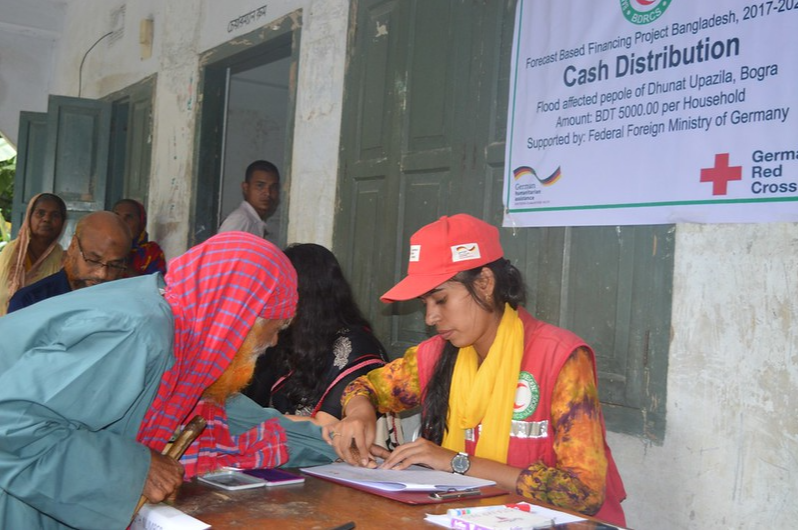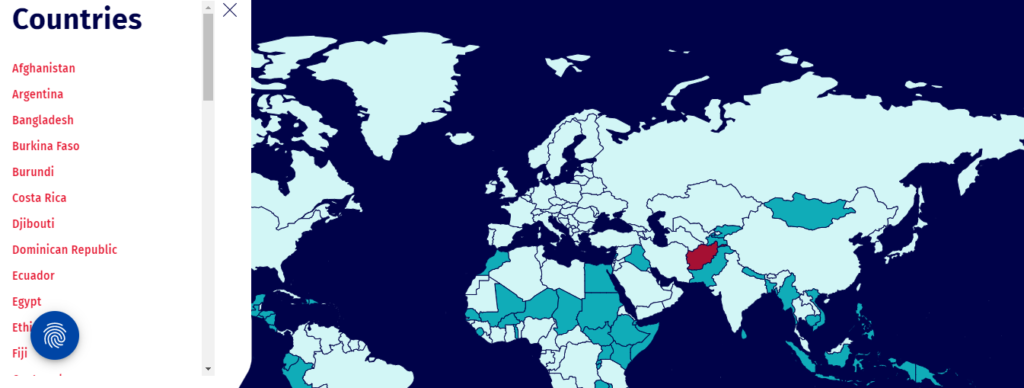Cash-based anticipatory action around the world
Find out more about the use of cash-based early actions with examples from different countries.

The Red Cross Red Crescent Movement and Anticipatory Action: a commitment to collaborate
Anticipatory action began with pilots initiated by the German Red Cross. Today, anticipatory approaches are being implemented in over 60 countries, thanks to commitments from governments, donors and key stakeholders such as IFRC, WFP, FAO, the Start Network and OCHA. It is crucial that these initiatives complement the wider work of the development and climate community to strengthen government systems, especially national disaster risk-management frameworks.
There are several existing networks, forums, partnerships and platforms that are directly supporting, or highly relevant to anticipatory action. Global initiatives to scale up anticipatory action approaches include the Anticipatory Action Focus Task Force, the Risk Informed Early Action Partnership (REAP) and the Anticipation Hub.
To browse all examples of Early Actions, visit the Anticipation Hub’s interactive map by clicking here.

Overview of Red Cross/Red Crescent forecast-based actions that use cash and voucher assistance as a modality:
| Country | Hazard | Action | Lead time | Overview |
| Argentina | Flood | Cash | EAP being developed, cash transfer under consideration to cover evacuation & basic needs. | |
| Bangladesh | Flood | Unconditional Cash | 10 days | Distribution of unconditional cash grants of 4500 BDT (approximately USD 53). These grants are meant to help people evacuate or otherwise prepare for the floods, thereby reducing their losses. |
| Ecuador | Volcanic ash | Unconditional Cash | Not fixed | Cash is delivered by debit card if >10mm ash is projected to fall in an area. Cash is meant to allow households to meet their basic needs (food, animal transport etc). |
| Ecuador | El Niño | Unconditional Cash | 7 days | Based on the 7-day forecast cash grants of USD200 are delivered through IFRC VISA debit cards. |
| Kenya | Drought | Unconditional Cash | Not fixed | The Kenyan Red Cross (KRCS) does not have an official EAP approved yet but do already “act early”, whereby they utilize drought early warning from Kenya Famine Early Warning Systems Network (FEWSNET) and National Drought Management Authority (NDMA) to implement early actions to reduce food insecurity- related morbidities and mortalities and negative coping strategies. The early actions included pre-registration of vulnerable households in drought prone areas and multi-purpose cash transfers to drought affected population in selected counties in Kenya. It is aligned to support the national social protection programme, the HSNP in arid and semi-arid counties: a drought scalability framework has thresholds based on the vegetation index, triggering cash transfers as each threshold is reached. The KRCS currently works with national stakeholders to develop an EAP for drought. More information is available in these case studies: –Drought Early Waring Early Action: Using Cash Assistance in Kenya –A buffer against the drought – Riding on the Hunger Safety Net Programme platform to deliver aid to the most vulnerable through the use of Bank Accounts |
| Kenya | Floods | Cash /CfW | 7 days | The KRCS currently works with national stakeholders to develop an EAP for floods (validation in process). In the draft EAP, KRCS proposed CfW to place flood markers and conditional cash grants or vouchers toward evacuation support to move prior to flooding to their location of choice (hosts, family, friends) or a temporary shelter site. KRCS also considers CfW to clear drains. |
| Mongolia | Dzud* | Cash | 3 months | Unconditional cash grants are distributed to herder households to help them meet their specific needs during the Dzud*. With limited resources and manpower herders struggle to stock hay fodder for their livestock until the grass starts growing. Cash grants allow herders to meet a variety of needs such as hay, fodder, warm clothes, and medicine.*The Dzud is a natural disaster consisting of a summer drought resulting in inadequate pasture and production of hay, followed by very heavy winter snow and winds. The heavy snow prevents livestock and wildlife from accessing pasture and thus leading to mass death basically from starvation. |
| Peru | Intense rainfall, El Niño | Cash | 7 days | Most vulnerable (based upon selection criteria) receive cash grants of USD150 delivered through National Bank upon presentation of an ID card. Preparations start based on the 30-day forecast. |
| Philippines | flood | CfW | 2 days | Teams of 20 farmers and/or fishermen are provided with cash for work to construct temporary livestock pens for evacuated animals at each evacuation site. Blog link to simex on cash and SRSP for flood EA |
| Philippines | cyclone / typhoon | CfW | 3 days | Cash for work is provided for people to help with early harvest of crops, to help reinforce houses, or clean drains, as appropriate given the season. |
| Southern Africa Regional Project (SAP):eSwatini, Lesotho, Namibia, Mozambique | drought | Feasibility study ongoing. | weeks, months (to be defined) | German Red Cross, British Red Cross, Climate Centre, Netherlands Red Cross 510 initiative, currently support some National Societies as part of the Anticipatory Action SAP for drought. Drought feasibility studies as well as cash preparedness are currently ongoing. Cash is highly likely to be selected as an early action in Lesotho, eSwatini and Namibia. Lesotho: the next hazard identified for EAP development will be heavy snowfall. UN agencies currently plan to engage in anticipatory action. |
| Uganda | flood | Cash | 7 days | Distribution of electronic /mobile money cash & voucher assistance to facilitate evacuation and help affected families meet their basic needs. |
| Nepal | Riverine floods & cold waves | Cash | This project, started in 2020, aims to integrate shock responsiveness and anticipatory action into Nepal’s Social Security Allowance (SSA) programme to inform the development of more responsive and anticipatory social protection and early warning systems that protect the most vulnerable before, during, and aftershocks. In November 2021, the Nepal Red Cross Society, with support from the Danish Red Cross piloted the use of multi-purpose cash grants to current SSA recipients affected by unseasonal floods in the west of Nepal. The grants were provided using the SSA social registry for targeting, the SMS communication system of the municipality, the SSA bank accounts of the recipients for the distribution and encashment process and finally, the SSA grievance/feedback mechanism was used to address challenges throughout the action. Lessons from this action are to be utilised to develop the SoPs to implement multi-purpose cash through the SSA system during the 2022 monsoon season in Nepal. | |
| Ethiopia | flood | Cash | 7 days | Global Floods awareness system (GLOFAS) forecast triggers a rapid assessment and beneficiary registrations. CVA support includes evacuation costs, livestock feed, CfW to clear and maintain drainage lines around homesteads. |
| Niger | Drought & food insecurity | voucher | This EAP has two triggers in two successive phases: 1) in April, with an online season forecast (SEAS5) and a lead time of 3 months. 2) in November, anticipating a future food crisis based on the food insecurity assessment observed by the Cadre Harmonisé/IPCI of IPC 3 or more for the following year’s lean season and the assessment of production conditions in addition to the assessment of the previous rainy season (GEOGLAM) early warning crop monitor (of below 50), with a lead time of five months. This includes a cash transfer to well working cereal banks (bank transfer), allowing them to increase their stock before prices rise too much or the availability of cereals decreases, and a cash transfer to households in the same community (using vouchers) enabling them to access the subsidized cereal banks for free. This scheme allows unconditional food access to 1,000 vulnerable HH and cut by half the grain cost for an additional 1,000 HH. |

